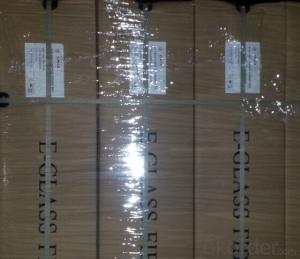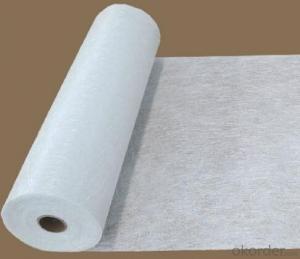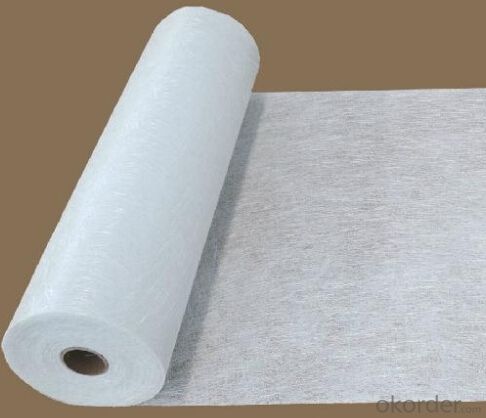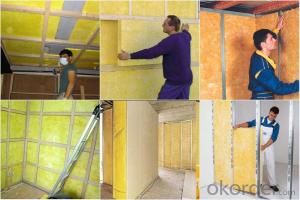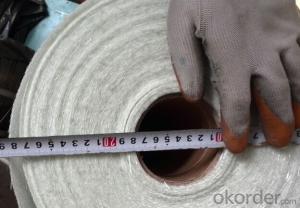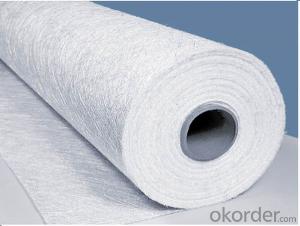Fiberglass Mat Tissue C Glass Fiber Chopped Strand Mat for FRP Tank & FRP Panel
- Loading Port:
- Shanghai
- Payment Terms:
- TT OR LC
- Min Order Qty:
- 4000 kg
- Supply Capability:
- 200000 kg/month
OKorder Service Pledge
OKorder Financial Service
You Might Also Like
Introduction of E-glass Chopped Strand Mat
Chopped strand mat is made from fiberglass chopped strands boned with powder binder or emulsion binder.
This products ischaracterized bg good combination of resin,easg operation ,good wet strengthretention,good laminate transparency
Chopped strand mat is used primarily for hand lay-up processes, filament winding and press molding of FRP products. Typical products include bathroom
accessories, pipe, building materials, automobiles, furniture and other FRP products.
Features of E-glass Chopped Strand Mat
1.Warp and weft rovings aligned in a parallel,flat manner and uniform tension .
2.Densely alighed fibers,providing high dimensional stability ans easy handing .
3.Good moldability,fast and complete resin wet-out ,enabling high productively .
4.Good transporsision and hign strength of the composite products.
5.Even thickness ,no fuzz ,no stain.
6.Fast wet-out ,products with high strength ,little loss for strength in damp situation.
Features of E-glass Chopped Strand Mat
1.the composit products have high dry and wet tensile strenth and good transparency.
2.Low fuzz ,dirt ,impurity and other stain
Images of E-glass Chopped Strand Mat
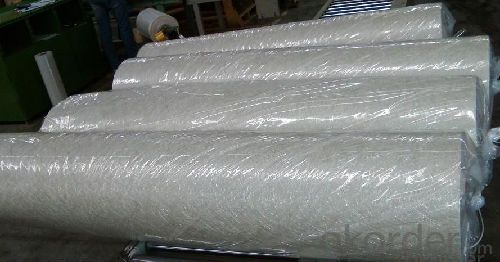

E-Glass Chopped Strand Mat Specification:
Property | Glass type | Weight(g/m2) | Width 200~3300 | Roll Weight | Moisture Content /% | Combustible Content /% | Breakage Strength /N |
Test Method | GB/T 1549 | ISO3374:2000 | ISO3374 | GB/T17470-1998 | ISO3344:1997 | ISO1887:1995 | ISO3342 |
EMC 80 | E-GLASS | 80±16 | ±5 | 6~50 | <0.2< span=""> | 13.6±0.35 | ≥200 |
EMC 100 | E-GLASS | 100±10 | ±5 | 6~65 | <0.2< span=""> | 9.5±0.35 | ≥170 |
EMC 150 | E-GLASS | 150±15 | ±5 | 6~97 | <0.2< span=""> | 8.0±0.35 | ≥40 |
EMC 225 | E-GLASS | 225±22 | ±5 | 6~150 | <0.2< span=""> | 5.0±0.6 | ≥60 |
EMC 300 | E-GLASS | 300±30 | ±5 | 6~180 | <0.2< span=""> | 4.0±0.6 | ≥90 |
EMC 450 | E-GLASS | 450±45 | ±5 | 6~180 | <0.2< span=""> | 3.8±0.6 | ≥120 |
EMC 600 | E-GLASS | 600±60 | ±5 | 6~240 | <0.2< span=""> | 3.6±0.6 | ≥150 |
EMC 900 | E-GLASS | 900±90 | ±5 | 6~190 | <0.2< span=""> | 3.4±0.6 | ≥180 |
FAQ of Chopped strand mat
1. Why Choose us?
CNBM is a stated own company, provide the guarantee for the best quality, best service and safety business.
2. How will we guarantee the quality?
a, ISO 9001-2008 quality control system;
b, Strict and regular quality control in production;
c, Inspeciation when loading into container before shippment;
d, Sample stock for one year for quality tracing and record.
3. What is your MOQ?
Our MOQ is one pallet.
4. Can you provide sample?
Yes, samples are in stock. we can offer free sample for you.
5. Payment terms?
We can accept L/C, T/T etc.
6. Do you offer OEM service?
Yes, we can print customers’ logo on the packaging;
And the size and specification can be produced and design according to your demand.
- Q: Does fiberglass mat tissue require any maintenance?
- Once installed, fiberglass mat tissue typically does not need any maintenance. This material is designed to be tough and long-lasting, capable of enduring various environmental conditions. Unlike other materials, fiberglass mat tissue is resistant to rot, corrosion, and decay, making it a low-maintenance choice for many applications. Nevertheless, it is crucial to emphasize that proper installation is essential to ensure the longevity and effectiveness of fiberglass mat tissue. Following the manufacturer's guidelines, it should be installed in a way that securely bonds and seals it to the surface. This will help prevent any potential issues or damage that could result from improper installation. Occasionally, fiberglass mat tissue may require cleaning to remove accumulated dirt or debris. This can be achieved by using mild soap and water or by adhering to the manufacturer's recommended cleaning instructions. In summary, while regular maintenance is not required for fiberglass mat tissue, it is important to promptly address any issues or damages to prevent further deterioration. Regular inspections and necessary repairs should be conducted to ensure the material's continued performance and longevity.
- Q: How does fiberglass mat tissue compare to other types of insulation materials?
- Fiberglass mat tissue is a type of insulation material that has its own unique characteristics and advantages when compared to other insulation materials. Firstly, fiberglass mat tissue is known for its excellent thermal insulation properties. It has a low thermal conductivity, meaning it effectively reduces the transfer of heat between the inside and outside of a building. This helps to keep buildings cooler in the summer and warmer in the winter, leading to energy savings and increased comfort. In addition to its thermal insulation capabilities, fiberglass mat tissue also offers excellent sound insulation. It helps to reduce noise transmission through walls and floors, creating a quieter and more peaceful indoor environment. This is particularly beneficial in commercial buildings, where noise reduction is important for productivity and customer satisfaction. Furthermore, fiberglass mat tissue is a lightweight and flexible material, making it easy to handle and install. It can be easily cut to fit around obstacles such as pipes and ducts, ensuring a tight and efficient insulation barrier. This ease of installation saves time and labor costs during construction or renovation projects. Another advantage of fiberglass mat tissue is its fire resistance. It is a non-combustible material, meaning it does not contribute to the spread of fire. This is especially crucial in buildings where fire safety is a top priority, such as hospitals, schools, and residential properties. Moreover, fiberglass mat tissue is durable and long-lasting. It does not degrade or lose its insulation properties over time, ensuring consistent energy efficiency and performance for many years. This durability makes it a cost-effective insulation choice, as it reduces the need for frequent replacement or maintenance. Lastly, fiberglass mat tissue is environmentally friendly. It is made from recycled glass and sand, which reduces the demand for raw materials. Additionally, it is recyclable at the end of its lifespan, further reducing waste and promoting sustainability. Overall, fiberglass mat tissue offers excellent thermal and sound insulation, ease of installation, fire resistance, durability, and environmental benefits. While other insulation materials may have their own advantages, fiberglass mat tissue is a versatile and reliable option for various applications.
- Q: Can fiberglass mat tissue be used for insulation in chemical storage tanks?
- Indeed, insulation in chemical storage tanks can be achieved using fiberglass mat tissue. The exceptional insulation properties of fiberglass render it a fitting substance for tanks that house chemicals. Typically composed of finely interwoven glass fibers, the fiberglass mat tissue constitutes a robust and long-lasting material. Its application to the inner walls of the tank effectively insulates and thwarts heat transfer. Furthermore, fiberglass exhibits corrosion resistance and can endure the detrimental effects of the chemicals commonly stored within these tanks, making it an optimal option for insulation in chemical storage tanks.
- Q: Does fiberglass mat tissue require any special precautions during disposal?
- Yes, fiberglass mat tissue does require special precautions during disposal. Due to its composition, fiberglass mat tissue can release fine particles and fibers into the air when handled or broken. These particles and fibers can be harmful if inhaled or come into contact with skin and eyes. Therefore, it is important to take certain precautions when disposing of fiberglass mat tissue. Firstly, it is recommended to wear appropriate personal protective equipment (PPE) such as gloves, goggles, and a respirator mask to minimize the risk of exposure. This will help prevent the inhalation of airborne particles and fibers and protect the skin and eyes from any potential irritation. Secondly, fiberglass mat tissue should be disposed of in sealed bags or containers to prevent any loose fibers from becoming airborne during transportation. It is also advisable to label the bags or containers as "hazardous" or "fiberglass waste" to alert others of the potential risks. Furthermore, it is important to follow local regulations and guidelines for the disposal of fiberglass mat tissue. Depending on the location, there may be specific requirements for handling and disposing of hazardous waste materials, including fiberglass. These regulations are in place to protect public health and the environment. In summary, fiberglass mat tissue does require special precautions during disposal to minimize the risk of exposure to harmful particles and fibers. Wearing appropriate protective equipment, using sealed containers, and following local regulations are essential steps to ensure safe disposal practices.
- Q: What is the tensile strength of fiberglass mat tissue?
- The tensile strength of fiberglass mat tissue typically ranges between 30 and 150 pounds per inch (lb/in). However, it is important to note that the exact tensile strength can vary depending on the specific type and quality of fiberglass mat tissue being used.
- Q: Does fiberglass mat tissue have any fire-resistant properties?
- Yes, fiberglass mat tissue does have fire-resistant properties. Fiberglass is inherently fire-resistant due to its composition. It is made from a combination of glass fibers and a thermosetting resin, which gives it its fire-resistant properties. When exposed to high temperatures or flames, fiberglass mat tissue does not easily ignite or burn. Instead, it resists the spread of flames and can help to contain a fire. This makes fiberglass mat tissue a suitable material for applications where fire protection is required, such as insulation, fire barriers, and fireproof panels. However, it is important to note that while fiberglass is fire-resistant, it is not completely fireproof and can still melt or burn under extreme conditions.
- Q: What is the delamination strength of fiberglass mat tissue?
- The ability of fiberglass mat tissue to resist the separation or detachment of its layers, known as delamination strength, is influenced by various factors. These factors include the quality of the resin used, the thickness and density of the mat, and the manufacturing process. To ensure durability and structural integrity, fiberglass mat tissue is typically designed with a high delamination strength. It is composed of multiple layers of glass fibers held together by a binder or resin. The bonding between these layers is crucial in preventing delamination. Various testing methods, such as the peel test, can determine the delamination strength of fiberglass mat tissue. This test measures the force required to separate the layers and provides valuable information about the adhesive strength between them, helping to assess the material's overall quality. The delamination strength may vary depending on the specific application and requirements. Different industries, such as construction, automotive, marine, and aerospace, may have different delamination strength specifications for their fiberglass mat tissue. Manufacturers typically provide technical data or specifications indicating the delamination strength of their products. It is important to consider external factors that can influence the delamination strength of fiberglass mat tissue, such as exposure to extreme temperatures, moisture, or chemical substances. Proper installation, maintenance, and adherence to recommended usage guidelines are crucial in maintaining the desired delamination strength and overall performance of the material.
- Q: How does the thickness of fiberglass mat tissue affect its performance?
- The thickness of fiberglass mat tissue directly affects its performance. A thicker tissue provides increased strength, durability, and insulation properties. It also enhances the material's ability to absorb impact and resist damage. Thinner tissues, on the other hand, offer greater flexibility and easier handling. Therefore, choosing the appropriate thickness of fiberglass mat tissue is crucial to achieve desired performance characteristics in various applications.
- Q: How is fiberglass mat tissue used in the automotive industry?
- The automotive industry relies heavily on fiberglass mat tissue for various purposes. This versatile material offers numerous advantages, making it an ideal choice for multiple applications. Reinforcing composite materials is one of the primary uses of fiberglass mat tissue in the automotive industry. It is commonly employed as a reinforcement layer during the production of car panels, hoods, roofs, and doors. By enhancing the structural integrity of these components, the fiberglass mat tissue makes them more durable and resistant to impact and external forces. This reinforcement property contributes to the overall safety of the vehicle. Furthermore, fiberglass mat tissue is also utilized for sound insulation in the automotive industry. This material possesses excellent sound absorption properties, effectively reducing noise and vibrations within the vehicle. By incorporating fiberglass mat tissue in areas like the floor, doors, and roof, automakers can significantly improve the overall acoustic comfort of the vehicle, providing a quieter and more enjoyable driving experience. Moreover, fiberglass mat tissue finds application in thermal insulation within the automotive industry. Acting as a barrier against heat transfer, this material helps regulate the temperature inside the vehicle. By incorporating fiberglass mat tissue in areas such as the engine compartment, exhaust system, and undercarriage, automakers can insulate the vehicle from excessive heat, preventing overheating and ensuring optimal performance. In conclusion, fiberglass mat tissue is extensively used in the automotive industry for reinforcement, sound insulation, and thermal insulation purposes. Its versatility makes it an indispensable material in vehicle manufacturing, contributing to improved safety, comfort, and performance.
- Q: How does fiberglass mat tissue compare to fiberglass mesh?
- Fiberglass mat tissue and fiberglass mesh are both used for reinforcing and strengthening various materials, but they have key differences in their composition and applications. Fiberglass mat tissue is a thin, non-woven material made up of randomly oriented glass fibers bonded together with a binder. It is typically used for surface finishing, especially in the production of composite materials, where it provides a smooth and aesthetically pleasing surface. Fiberglass mat tissue is also used for insulation purposes due to its thermal and acoustic properties. On the other hand, fiberglass mesh consists of woven glass fibers, forming a grid-like pattern. This mesh is commonly used for reinforcement in construction and other applications where strength and durability are required. It is often used in combination with cement or other bonding agents to enhance the structural integrity of walls, floors, and other surfaces. In summary, while both fiberglass mat tissue and fiberglass mesh serve specific purposes in reinforcement, they differ in their composition, with mat tissue being non-woven and mesh being woven. The choice between the two depends on the specific requirements of the project, such as the need for surface finishing or structural reinforcement.
Send your message to us
Fiberglass Mat Tissue C Glass Fiber Chopped Strand Mat for FRP Tank & FRP Panel
- Loading Port:
- Shanghai
- Payment Terms:
- TT OR LC
- Min Order Qty:
- 4000 kg
- Supply Capability:
- 200000 kg/month
OKorder Service Pledge
OKorder Financial Service
Similar products
Hot products
Hot Searches
Related keywords

